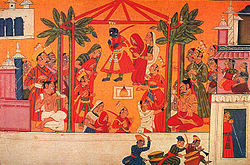Saturday, October 30, 2021
Friday, October 29, 2021
Arabian Literature: Arabian Nights (Aladdin and the Magic Lamp)
Aladdin and the Magic Lamp from Arabian Nights
Thursday, October 28, 2021
Arabian Literature: Arabian Nights (The Lady and her Five Suitors )
The Lady and Her Five Suitors from the Arabian Nights
Wednesday, October 27, 2021
Indian Literature: Ramayana
Ramayana
Indian Literature: Panchatantra
The Panchatantra (The Lion Makers, The Duel Between the Elephant and the Sparrow)
The Panchatantra is an Indian collection of stories about animals that are connected to each other. According to Wikipedia, Panchatantra is written in Sanskrit poetry and prose and structured inside a frame plot, which is also referred to as the Panchatantra. Based on old oral tradition, the surviving work is determined to have been created between 200 BCE and 300 CE. According to some recensions, Vishnu Sharma is believed to be the author of this literary text, while others credited the work to Vasubhaga, both of which may be pen names for the author. In Hindu Literature, stories about animals are among one of the oldest type of literature based on oral traditions.
The stories in Panchatantra is one of the most well known stories in the world, that is believed to be the most often translated literary pieces in India. Panchatantra is written and translated in most language of India. There are about 200 types of the text that is written in over 50 languages and the original Panchatantra is written in Hindi.
The Lion Makers
The Duel Between the Elephant and the Sparrow
-
The Panchatantra (The Lion Makers, The Duel Between the Elephant and the Sparrow) The Panchatantra is an Indian collection of stor...





